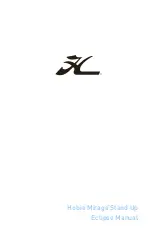
Interior Equipment
8-1
Interior Equipment
8.1 Companionway Door
The cabin is accessed through a sliding door.
Behind the companionway door is a screen
door. Lockable latches secure the doors in
the closed position. A vinyl-covered latch
secures the doors in the open position. DO
NOT leave the door unlatched. Latch it in the
full OPEN or full CLOSED position.
The doors are made of acrylic plastic. Acrylic
plastic scratches easily and can chip. Refer to
section 11, Routine Maintenance, for proper
care of acrylic plastic.
CAUTION
!
Keep the cabin door latched in the
open or closed position. The door is
heavy and slides easily. If the door is
unlatched, it could slide unexpectedly
as the boat rocks, causing injury or
damage.
8.2 Main Cabin
Cabin interior arrangement
Microwave
To operate the microwave, turn ON the
MICROWAVE breaker on the AC Main Distri-
bution Panel (MDP). Refer to the microwave
owner’s manual for additional operating and
maintenance information.
8.3 Carbon Monoxide Detector
Read about carbon monoxide, its hazards,
and the carbon monoxide detector in section
9, Safety Equipment.
8.4 Climate Control
The reverse cycle air conditioner can be
operated to cool or heat. The cabin air con-
ditioner is located outboard of the compan-
ionway steps and just aft of the microwave.
Access this unit by removing the compan-
ionway steps and removing the panel in the
microwave cabinet. Do not store items in this
compartment. Items stored on or immediately
next to the air conditioning unit could cause
damage to the air conditioner or be damaged
by heat or condensation. The unit is con-
trolled using the thermostat on the AC MDP.
To operate the unit first turn ON the COOL
-
ING PUMP breaker and then the CABIN AIR
breaker on the AC MDP.
The cold air return is located on the face of
the microwave cabinet. Do not obstruct the
air return in order to obtain maximum effi-
ciency from the air conditioner.
The air conditioner is self-contained and sea
water cooled. The cooling pump supplies sea
water to the unit, which cools the condensing
unit and is discharged overboard. The pump
is located in the aft cockpit machinery space.
This pump also supplies cooling water to the
optional cockpit air conditioner.
Sea water is supplied to the pump from a
thru-hull fitting located in the hull near the
pump. A sea strainer between the pump and
thru-hull fitting protects the system from con
-
taminants that can damage the pump or the
air conditioning system. Periodically clean
the sea strainer basket to make sure the sea
water pump receives adequate water.
Summary of Contents for S428 SPORT
Page 1: ...OWNER S MANUAL DECEMBER 2020...
Page 3: ...This page intentionally left blank...
Page 4: ...Operator Notes...
Page 6: ...Safety Information Operator Notes...
Page 22: ...Safety Labels 16 Operator Notes...
Page 28: ...General Information 22 Operator Notes...
Page 44: ...Fuel Systems 3 6 Operator Notes...
Page 47: ...Electrical Systems 4 3 Main DC Distribution Panel DC MDP...
Page 52: ...Electrical Systems 4 8 WASHDOWN...
Page 60: ...Electrical Systems 4 16 Operator Notes...
Page 70: ...Plumbing Systems 5 10 Operator Notes...
Page 72: ...Ventilation Systems 6 2 Operator Notes...
Page 79: ...Exterior Equipment 7 7...
Page 80: ...Exterior Equipment 7 8...
Page 86: ...Exterior Equipment 7 14 Operator Notes...
Page 90: ...Interior Equipment 8 4 Operator Notes...
Page 100: ...Safety Equipment 9 10 Operator Notes...
Page 112: ...Operation 10 12 Operator Notes...
Page 120: ...Routine Maintenance 11 8 Operator Notes...
Page 126: ...Seasonal Maintenance 12 6 Operator Notes...
Page 134: ...Maintenance Schedule B 2 Date Hours Dealer Service Repairs...
Page 135: ...Maintenance Schedule B 3 Date Hours Dealer Service Repairs...
Page 136: ...Maintenance Schedule B 4 Date Hours Dealer Service Repairs...
Page 137: ...Boating Accident Report C 1...
Page 138: ...Boating Accident Report C 2...
Page 139: ...Boating Accident Report C 3...
Page 140: ...Boating Accident Report C 4...
Page 141: ...Boating Accident Report C 5...
Page 142: ...Boating Accident Report C 6...
Page 143: ...Float Plan D 1...
Page 144: ...Float Plan D 2...
Page 146: ...Float Plan D 4 Operator Notes...
Page 150: ...Troubleshooting Guide E 4 Operator Notes...
Page 160: ...Schematics F 10...
Page 163: ...Schematics F 13...
Page 164: ...Schematics F 14...
Page 165: ...Schematics F 15...
Page 166: ...Schematics F 16...
Page 167: ...Schematics F 17...
Page 168: ...Schematics F 18...
Page 169: ...Schematics F 19...
Page 170: ...Schematics F 20...
Page 171: ...Schematics F 21...
Page 172: ...Schematics F 22...
Page 173: ...Schematics F 23...
Page 174: ...Schematics F 24...
Page 175: ...Schematics F 25...
Page 176: ...Schematics F 26...
Page 177: ...Schematics F 27...
Page 178: ...Schematics F 28...
Page 179: ...Schematics F 29...
Page 180: ...Schematics F 30...
Page 181: ...Schematics F 31...
Page 182: ...Schematics F 32...
Page 183: ...Schematics F 33...
Page 184: ...Schematics F 34...
Page 185: ...Schematics F 35...
Page 186: ...Schematics F 36...
Page 187: ...Additional Information G 1...
Page 188: ...Additional Information G 2...
Page 194: ...Aquatic Invasive Species H 4 Operator Notes...
Page 195: ...This page intentionally left blank...
Page 196: ......
















































